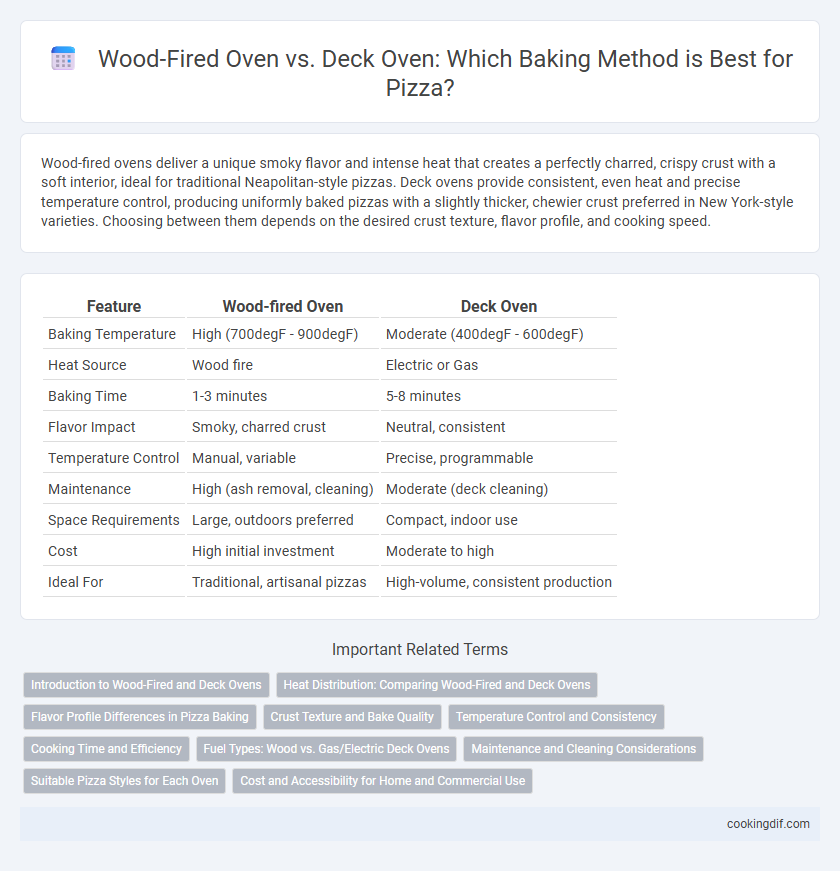Wood-fired ovens deliver a unique smoky flavor and intense heat that creates a perfectly charred, crispy crust with a soft interior, ideal for traditional Neapolitan-style pizzas. Deck ovens provide consistent, even heat and precise temperature control, producing uniformly baked pizzas with a slightly thicker, chewier crust preferred in New York-style varieties. Choosing between them depends on the desired crust texture, flavor profile, and cooking speed.
Table of Comparison
| Feature | Wood-fired Oven | Deck Oven |
|---|---|---|
| Baking Temperature | High (700degF - 900degF) | Moderate (400degF - 600degF) |
| Heat Source | Wood fire | Electric or Gas |
| Baking Time | 1-3 minutes | 5-8 minutes |
| Flavor Impact | Smoky, charred crust | Neutral, consistent |
| Temperature Control | Manual, variable | Precise, programmable |
| Maintenance | High (ash removal, cleaning) | Moderate (deck cleaning) |
| Space Requirements | Large, outdoors preferred | Compact, indoor use |
| Cost | High initial investment | Moderate to high |
| Ideal For | Traditional, artisanal pizzas | High-volume, consistent production |
Introduction to Wood-Fired and Deck Ovens
Wood-fired ovens utilize radiant heat from burning wood to produce intense temperatures often exceeding 900degF, imparting a unique smoky flavor and achieving a crisp yet chewy pizza crust. Deck ovens employ stone or ceramic surfaces heated by gas or electricity, offering precise temperature control and even heat distribution for consistent baking results. Both ovens cater to different pizza styles, with wood-fired ovens ideal for Neapolitan pizzas and deck ovens suited for New York-style or thicker crusts.
Heat Distribution: Comparing Wood-Fired and Deck Ovens
Wood-fired ovens deliver intense, radiant heat that penetrates pizza crusts quickly, creating a unique char and smoky flavor due to the direct flame and hot oven walls. Deck ovens use evenly heated stone or ceramic decks, providing consistent, steady heat that ensures uniform cooking and a crisp crust without the distinctive smoky notes. Heat distribution in wood-fired ovens is more variable and dynamic, while deck ovens maintain stable temperatures ideal for controlled baking environments.
Flavor Profile Differences in Pizza Baking
Wood-fired ovens create a distinct smoky aroma and charred crust in pizzas, enhancing flavor with unique caramelization and subtle wood smoke infusion. Deck ovens offer consistent heat and moisture retention, producing evenly baked crusts with a slightly softer texture and balanced browning. The choice between wood-fired and deck oven baking significantly influences a pizza's flavor profile, texture, and overall mouthfeel.
Crust Texture and Bake Quality
Wood-fired ovens reach temperatures of up to 900degF, producing a uniquely charred and airy crust with a crisp exterior and soft interior due to rapid, intense heat. Deck ovens operate at lower temperatures, around 500-600degF, delivering consistent heat that yields a uniform, thicker crust with a chewy texture and even bake quality. The choice between wood-fired and deck ovens significantly influences crust texture, where wood-fired ovens excel in creating a more artisanal, blistered crust, while deck ovens provide controlled, consistent crust development ideal for commercial baking.
Temperature Control and Consistency
Wood-fired ovens reach higher peak temperatures, often exceeding 900degF, enabling rapid baking with a unique smoky flavor but require skilled temperature control due to fluctuating heat patterns. Deck ovens maintain consistent temperatures typically between 500degF and 600degF, providing precise control and even heat distribution for uniform crust texture across batches. This consistency makes deck ovens ideal for pizzerias prioritizing repeatable results, while wood-fired ovens excel in artisanal, high-temperature cooking styles.
Cooking Time and Efficiency
Wood-fired ovens typically offer faster cooking times, often baking pizzas in 90 seconds to 3 minutes due to their high temperatures reaching up to 900degF (482degC). Deck ovens operate at lower temperatures, generally between 500degF to 600degF (260degC to 315degC), resulting in cooking times of 5 to 7 minutes per pizza but provide consistent heat distribution and energy efficiency. For high-volume pizzerias, deck ovens deliver greater efficiency with more uniform baking, while wood-fired ovens excel in rapid cooking and imparting a distinct smoky flavor.
Fuel Types: Wood vs. Gas/Electric Deck Ovens
Wood-fired ovens utilize hardwood fuel, imparting a distinct smoky flavor and high, radiant heat that enhances pizza crust texture and caramelization. Gas and electric deck ovens provide precise temperature control and consistent heat distribution, often preferred for commercial efficiency and ease of use. The choice between wood and gas/electric fuel impacts cooking times, operational costs, and the overall flavor profile of the pizza.
Maintenance and Cleaning Considerations
Wood-fired ovens require regular removal of ashes and soot buildup to maintain optimal heat and avoid flavor contamination, with periodic chimney cleaning essential to prevent blockages. Deck ovens demand routine cleaning of stone decks to prevent charring and food residue accumulation, along with checking and maintaining seals and temperature controls for consistent baking performance. Proper maintenance of both oven types directly impacts pizza quality and appliance longevity, making cleaning frequency and method critical factors.
Suitable Pizza Styles for Each Oven
Wood-fired ovens excel in producing Neapolitan-style pizzas with their high heat and smoky flavor, ideal for thin, soft crusts and quick baking times. Deck ovens are better suited for New York-style and Sicilian pizzas, offering consistent temperature control that supports thicker, chewier crusts and longer bake durations. Each oven type enhances specific pizza characteristics, influencing crust texture, flavor complexity, and cooking speed.
Cost and Accessibility for Home and Commercial Use
Wood-fired ovens generally have higher initial costs due to specialized materials and installation, making them less accessible for home use but preferred in commercial settings for authentic flavor. Deck ovens offer a more affordable upfront investment and easier maintenance, increasing accessibility for both home cooks and small businesses. Commercial users benefit from deck ovens' consistent temperature control and quicker cooking times, providing cost efficiency in high-volume pizza production.
Wood-fired oven vs Deck oven for baking method Infographic

 cookingdif.com
cookingdif.com